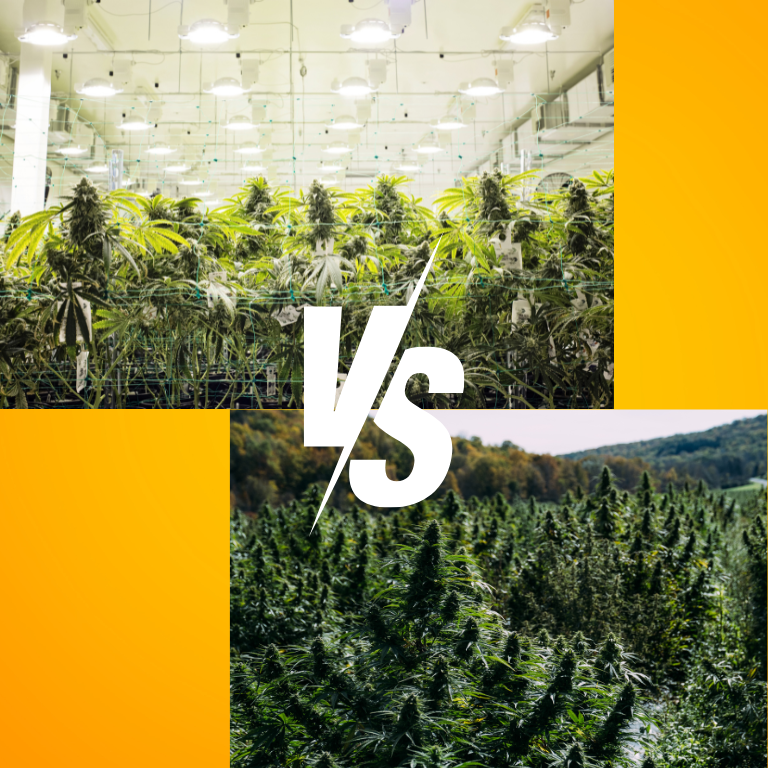Cannabis Growing: The Pros & Cons of Indoor vs. Outdoor

Pros & Cons of Indoor vs. Outdoor Cannabis Growing
Growing cannabis can be a rewarding experience, whether done indoors or outdoors. Both methods come with their own set of advantages and disadvantages, making the choice dependent on various factors including budget, space, climate, and personal preferences. This article delves into the pros and cons of indoor vs. outdoor cannabis growing to help you make an informed decision.
Understanding Indoor Cannabis Growing
Indoor cannabis growing involves cultivating plants in a controlled environment. This method provides growers with the ability to manipulate various factors to create optimal conditions for the plants.
Advantages of Indoor Cannabis Growing
Controlled Environment: Indoor growing allows for precise control over temperature, humidity, light, and air circulation, leading to a more consistent and potentially higher-quality yield.
Year-Round Cultivation: Unlike outdoor growing which is subject to seasonal changes, indoor growing can be done throughout the year.
Pest and Disease Management: With a controlled environment, there is a lower risk of pests and diseases compared to outdoor growing.
Stealth and Security: Indoor growing offers greater privacy and security, which can be particularly important in regions where cannabis cultivation is regulated or stigmatized.
Disadvantages of Indoor Cannabis Growing
High Initial Costs: Setting up an indoor grow room can be expensive. Costs include lighting, ventilation, climate control systems, and other equipment.
Energy Consumption: Indoor growing relies heavily on artificial lighting and climate control, leading to high energy consumption and associated costs.
Space Limitations: Indoor growing is limited by the size of the grow space, which can restrict the number of plants and their potential size.
Understanding Outdoor Cannabis Growing
Outdoor cannabis growing involves cultivating plants in natural conditions. This method takes advantage of the environment’s resources, such as sunlight and rain.
Advantages of Outdoor Cannabis Growing
Cost-Effective: Outdoor growing eliminates the need for expensive equipment and energy consumption, making it a more cost-effective option.
Natural Growth: Plants grown outdoors benefit from natural sunlight, which can result in healthier and more robust plants.
Higher Yields: With fewer space constraints, outdoor growing can produce larger plants and potentially higher yields.
Eco-Friendly: Outdoor cultivation is more environmentally friendly, as it utilizes natural resources and reduces the carbon footprint associated with indoor growing.
Disadvantages of Outdoor Cannabis Growing
Climate Dependency: Outdoor growing is heavily dependent on the local climate, which can be unpredictable and affect the quality and quantity of the yield.
Pest and Disease Exposure: Plants are more exposed to pests, diseases, and wildlife, which can damage crops and reduce yield.
Limited Growing Season: Outdoor growing is limited to the natural growing season, which can restrict the number of harvests per year.
Security Concerns: Outdoor plants are more vulnerable to theft and vandalism, particularly in areas where cannabis cultivation is illegal or frowned upon.
Comparative Analysis: Indoor vs. Outdoor Cannabis Growing
Yield and Quality: Indoor growing generally offers more control over the final product’s quality. The controlled environment can lead to consistent and high-quality yields. In contrast, outdoor growing can produce higher yields but with more variability in quality due to environmental factors.
Cost Implications: While the initial and operational costs of indoor growing are significantly higher, the potential for multiple harvests per year can offset these costs over time. Outdoor growing, with its minimal setup costs, offers a more affordable option but with a single annual harvest, limiting potential revenue.
Environmental Impact: Indoor growing has a higher environmental impact due to energy consumption and resource use. Conversely, outdoor growing is more sustainable and eco-friendly, relying on natural sunlight and rainwater.
Risk Factors: Indoor growing reduces risks related to weather, pests, and security, providing a safer and more predictable growing environment. Outdoor growing, however, exposes plants to various natural risks, including weather fluctuations, pests, and potential theft.
Choosing the Right Method for You
Assessing Your Environment: Consider the local climate and its suitability for outdoor growing. Regions with extreme weather conditions may necessitate indoor cultivation. For areas with mild and consistent climates, outdoor growing can be a viable option.
Budget Considerations: Evaluate your budget for initial setup and ongoing costs. Indoor growing requires a significant upfront investment but can yield multiple harvests annually. Outdoor growing is less expensive to start but may offer fewer harvests.
Legal and Social Factors: Understand the legal regulations and social attitudes towards cannabis cultivation in your area. Indoor growing offers greater privacy and security, which can be crucial in regions with strict regulations or negative social perceptions.
Both indoor and outdoor cannabis growing have their unique benefits and challenges. Your choice will depend on various factors, including climate, budget, and personal preferences. By understanding the pros and cons of each method, you can make an informed decision that best suits your needs and circumstances.











